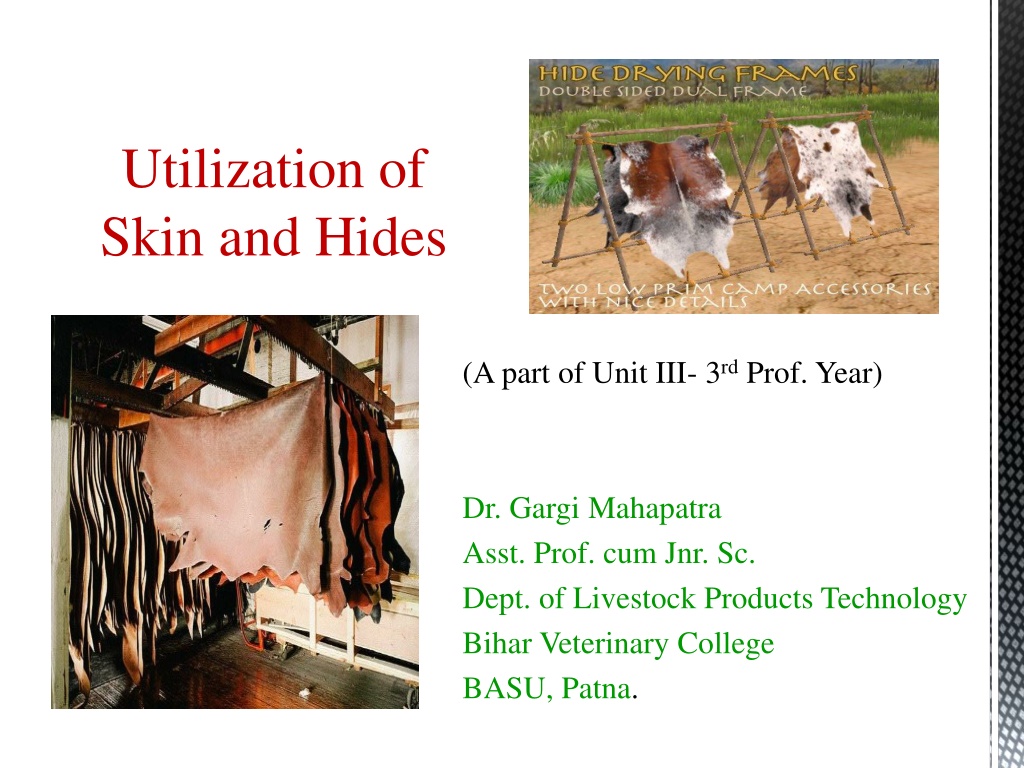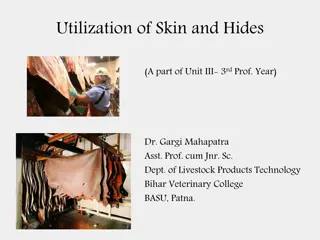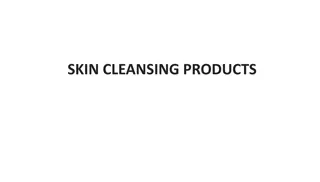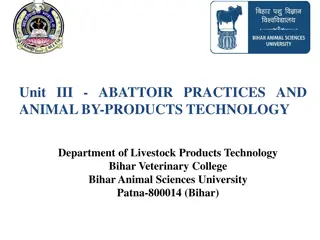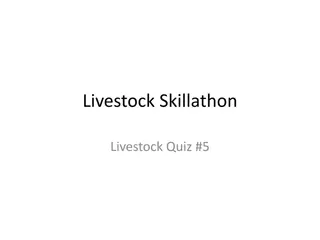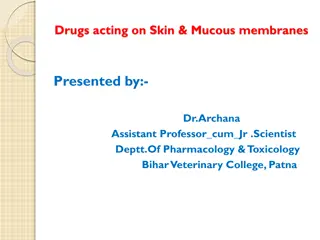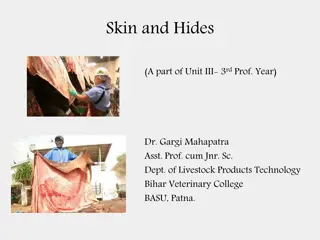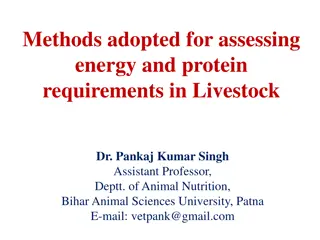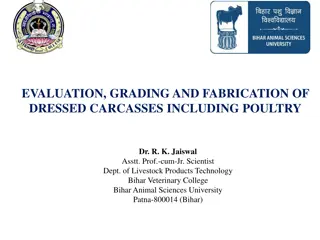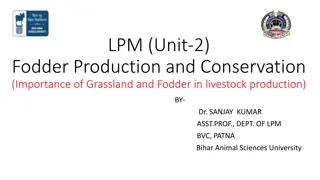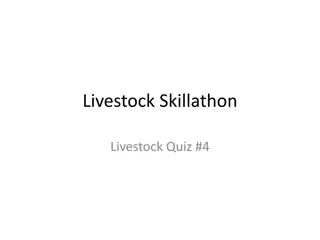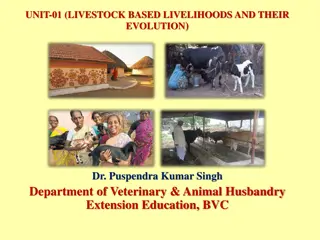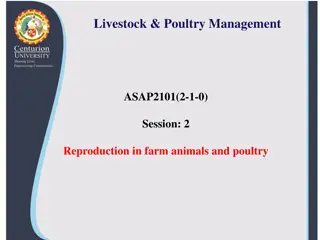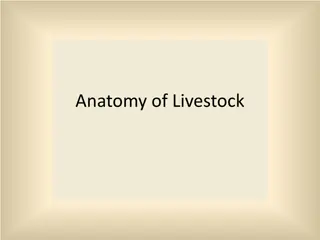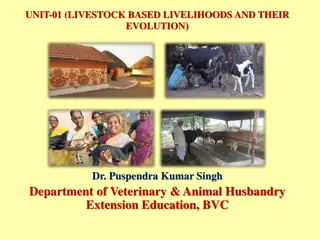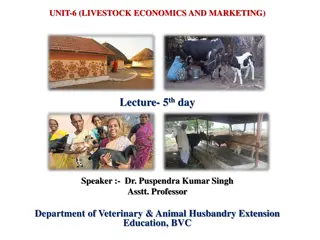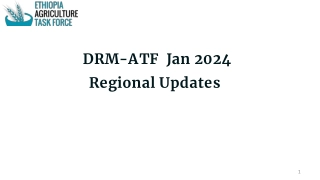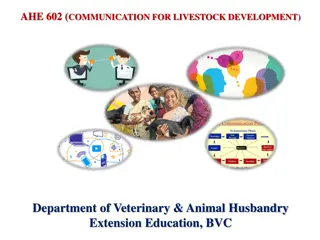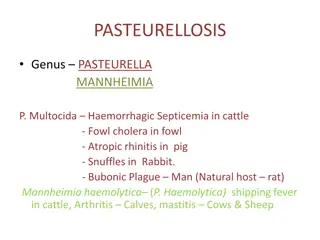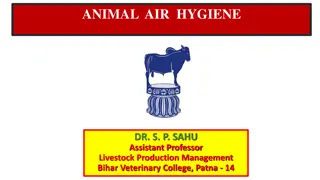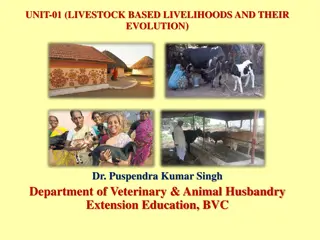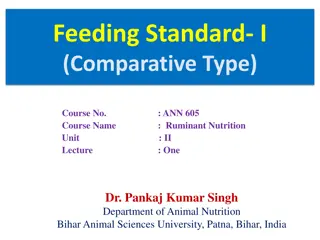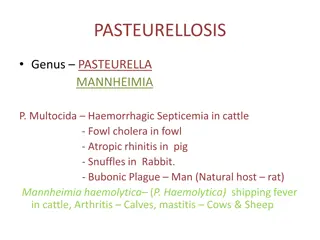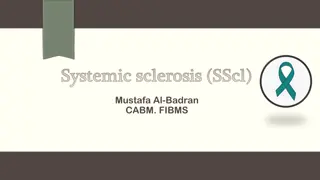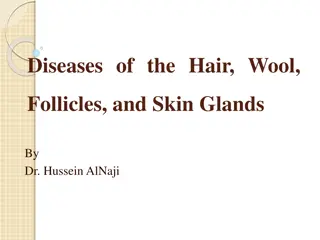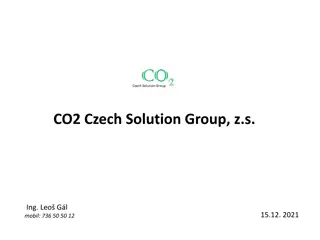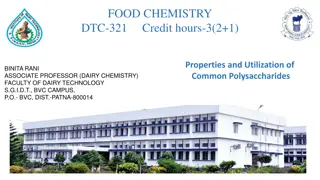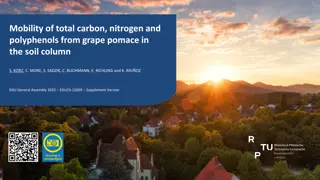Hide and Skin Utilization in Livestock Industry
This informative content delves into the various processes involved in the utilization of hides and skins in the livestock industry, covering topics such as preservation techniques, drying methods, conditioning, tanning, and post-tanning operations. It emphasizes the importance of proper handling from the initial steps of washing and drying to the final production of leather.
Download Presentation

Please find below an Image/Link to download the presentation.
The content on the website is provided AS IS for your information and personal use only. It may not be sold, licensed, or shared on other websites without obtaining consent from the author. Download presentation by click this link. If you encounter any issues during the download, it is possible that the publisher has removed the file from their server.
E N D
Presentation Transcript
Utilization of Skin and Hides (A part of Unit III- 3rdProf. Year) Dr. Gargi Mahapatra Asst. Prof. cum Jnr. Sc. Dept. of Livestock Products Technology Bihar Veterinary College BASU, Patna.
Destination of Hide/ Skin Hide/Skin Drying/ Curing Conditioning Tanning Post-Tanning Operations Leather (End/Final Product)
Skin of sheep and long haired goats are washed on the flesh side up. After drying the hides are conditioned and then sent to tanneries. Important Points Green Hides- Fresh hides which have been flayed, fleshed, trimmed and washed. These are delivered to the tanneries as early possible.
Preservation of Hides and Skin Drying First step in hide preservation- Methods Air Drying & Practiced in areas where relative humidity is low Hide Curing Done immediately after flaying Techniques Dry Salting Wet Salting Techniques Ground Drying Suspension Drying (Frame Drying, Line Drying & Tent Drying)
Ground Drying Hides stretched out fleshed side up on the ground and air dried. Advantages: Cheap, Easily adaptable by rural population Adequate for Fallen hides Disadvantages: Blemishes and Putrefaction at follicular level hence poor quality leather produced. High temperature(summers) causes wrinkling
Hides are dried in suspended manner Advantages Simple, cheap and effective way of drying. Easily adaptable in tropical countries. Free circulation of air around the hide. Skin becomes lighter thus cheaper to transport. Suspended Drying
Suspended Drying Techniques Tent Drying Frame Drying Practiced on angled frames fixed on a tripod/stand Hide supported on ground in shape of a tent by chords and wires Line Drying Skin suspended on horizontal chords with flesh side up, practiced for sheep and goat *Irrespective of the method of drying hide takes a minimum of 7 days to dry.
Wet Salting Hide Curing (Hide retains 35% water) Curing solution prepared (23 kg salt+ 62 kg water for 100 kg of hides) Hides soaked in pits, 1.25m deep. Soaking times varies from 2 days for fleshed hides to 2 weeks for un-fleshed hides. Brining liquid maintained at room temperature. Dry Salting (Hide retains 12% water) Hides kept flesh side up 2-3 mm thick layer of fine salt applied Weight of salt equal to weight of hide Hides stacked on one another, to a max. height of stack 1m. Practiced in rooms maintained at 15 C and 85-90% relative humidity.
Conditioning of Hides Washing and Soaking (Hides soaked in zinc chloride+ soda ash+ borax Solution) All proteins of blood and lymph removed Hide rehydrates and restores its shape Fleshing Extra flesh stripped off with a serrated knife Liming and Dehairing Hides soaked in saturated lime solution with 0.1% sodium sulphide Applied to loosen hair and epidermal cells
Contd. Washing and Deliming Hides washed with mild acid to neutralize the lime Batting Hides treated with proteolytic enzymes at pH 8.5 Results in soft and pliable pelt Such pelts tanned by vegetable tanning Pickling Pelts pickled in bath of 1% Sulphuric acid and 10% salt in water, maintained at a pH of 2-2.5 for 2-3 hrs Such pelts are tanned by chrome tanning process
Process of conversion of hides/ skins to insoluble and non-putrescible leather without destruction of original structure. Process requires approximately 5-6 hrs Tanning Types Vegetable Tanning Chrome Tanning
Delimed pelts are immersed in natural tanning liquor of progressively stronger concentration. The tannin diffuses and imparts uniform colour Used for heavy leather articles like belts, saddle, harness etc. Tanning producing plants are Avaran ( Cassia auriculata), Babul (Acacia arabia), Myrabalan (Terminalia chebula) Konnan (Cassia fistula). Vegetable Tanning
Chrome Tanning A more modern, quicker and popular technique. Yields softer, stronger and supple leather. Types 1. Single Bath Process- Chrome salts prepared in a solution and then applied on skin. The strength of the solution is then gradually increased Double Bath Process- Chemical interaction forming the chrome solution is practiced on skin itself. Usually sodiumbichromate is reacted with maltose and sulphuric acid to get chromic sulphates. Chromic sulphates are applied @ 1.5-2.0% at a pH of 2.5 , then increased to pH of 3.5. 2.
Post tanning Operations Setting out and Wiring Hide passed between two large rollers Remove excess of tanning liquor and moisture Splitting and Shaving Practiced to adjust leather thickness Dyeing To produce desired color Fat Liquoring Lubrication with oil to adjust firmness
Contd Contd Staking Staking Makes the leather more pliable Buffing Buffing Smooth the grain surface of leather for better appearance Final product is called buffed leather Glazing Glazing Done in case of chrome tanning Glass cylinders are rolled on the surface of the buffed leather This process produces high luster on the grain surface
